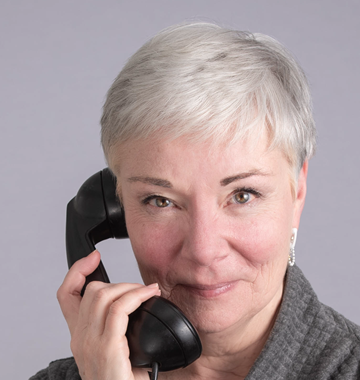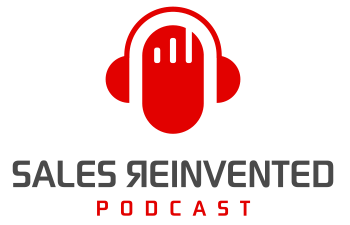Episode #405: Mary Jane Copps

Meet
Mary Jane Copps
Communication consultant/coach specializing in phone communication, giving sales & customer service teams confidence & skills to inspire conversations that result in trust, loyalty and increased revenue.
Our Mission Is To Change The Negative Perception Of Sales People
Our Vision Is A World Where Selling Is A Profession To Be Proud Of
Mary conducted a survey on the future of phone communication in business. She sent it to 724 Senior Executives around the world with a 15% response rate. The comments indicated that when it came to sales, cold-calling was still the preferred method of starting communication.
So how do you make your cold calls effective? Mary Jane—better known as “The Phone Lady”—shares her strategies in this episode of Sales Reinvented.
Outline of This Episode
- [0:47] What is cold-calling? Is it still relevant?
- [2:55] Is cold-calling an art and a science?
- [4:10] How Mary Jane prepares for cold-calling
- [5:47] Mary Jane’s effective opening lines
- [8:14] How to keep the conversation going
- [9:27] Indispensable tools, technology, and metrics
- [12:00] Mary Jane’s top cold-calling dos and don’ts
- [15:23] How Mary Jane handles objections
Is cold-calling an art and a science?
When Mary Jane was teaching herself how to sell, she discovered there was a specific psychology involved in creating great phone conversations. You have to craft how you’ll introduce yourself, engage them with open-ended questions, and improvise.
A great cold call is a conversation—not a presentation. You have to be able to improvise based on what they’re saying. You have to dig into what works so that your prospect reveals their challenge or problem.
Mary Jane’s effective opening lines
When you receive an unexpected call from someone you don’t know, two questions come to mind. Until those questions are answered, you won’t hear anything else.
- What’s this about?
- What’s it got to do with me?
Once those questions are answered—in 20 seconds or less—you can move toward a valuable conversation. Get right to the point.
Mary Jane will say, “This is Mary Jane Copps calling from The Phone Lady. The reason for my call today is..” Her next statement is about them, to demonstrate that she’s done her research.
She might say, “I understand you have a team of people making outbound calls. I work with similar teams in your industry to help them become more effective and create more revenue.” She then follows with an open-ended question like, “How do you choose the trainers that come in and work with your outbound sales team?”
What are Mary Jane’s top cold-calling dos and don’ts?
When you make a cold call, this is what you should and shouldn’t do:
- Do leave a message (don’t just hang up). Everyone knows you’ve called. You can’t create a relationship if you call and just hang up.
- Do your research ahead of time. Know what your prospect does and who they are.
- Make the call about the other person. You want them to experience the feeling that you chose to call them. You’ll get a totally different reaction.
- Combine all of your channels. Leave a voicemail and let them know you’ll send them an email. Send it immediately after the voicemail. In the email, give them an option to book the time for a phone call.
- Be careful of the language you’re using. Don’t say “I’m just calling” or “Maybe could we have this conversation” or use any iffy words. Don’t over-polite yourself out of the opportunity to have a great conversation.
- Don’t talk more than you listen. The sale is in what the prospect says—not what you say.
- Don’t push it if what you’re offering isn’t a fit. You don’t want a customer that isn’t a good fit. It’ll cost you time, energy, and money.
What amazing suggestions.
How Mary Jane handles objections
Mary Jane points out that an objection is often a test. It isn’t a rejection. The person on the other end of the phone has a question that they’re voicing as an objection. If someone says, “I have no idea how I can fit in another meeting in my schedule,” the question is, “How can I possibly meet with you? I’m too busy.”
You could say, “I hear that from so many clients. What I have is a flexible schedule. What time of the day is the most flexible for you?”
Listen to the whole conversation for some great ideas you can swipe and deploy immediately.
Connect With Paul Watts
Audio Production and Show notes by
PODCAST FAST TRACK
https://www.podcastfasttrack.com
Learn More About Mary Jane Copps
What was a pivotal moment or experience in your career that shaped your approach to cold calling, and how did it change your perspective or strategy?
I’ll share two pivotal moments. The first took place in 1988. I had started my first company, with no sales experience and, as a consequence, was not producing any revenue. I was enjoying great conversations with prospects, but making no money at all. I decided to record my calls to see if I could figure out the problem. I was 29 years old and calling CEOs and senior executives throughout North America. I was nervous and constantly visualizing that I was interrupting them. On every call I started with “Hi so-and-so, I’m Mary Jane Copps and I’m just calling to … . It was obvious on the recording that the word “just” was the first problem I needed to solve. The CEO didn’t hear nervous and polite. They heard “I’m just calling. I don’t have anything of value to say to you.” Or they heard “I’m just calling. I’m calling names on a list and you are one of them.” Once I stopped using the word “just”, I started making money.
A second pivotal moment happened after I sold my shares in my first company. I helped a friend build his software business on a part time basis. Once we reached his goal, I said I’d be moving on to get a full-time job. His reaction was “You need to start another business. You need to teach people how to talk on the phone.” My reaction was “That’s not a business, that’s common sense.” He insisted I continue to share his office space and give it a try. That was 18 years ago. I’m so glad I took his advice!
Can you share a specific tactic or approach you’ve used in cold calling that significantly increased your success rate? Please provide a brief example or case study.
I have increased both my success rate and that of my clients by acknowledging when we “over polite” ourselves out of conversations and opportunities. For example, when we call and ask someone we don’t know “How are you?”. Or when we say “Is this a good time?” These questions serve to make the other person more defensive and cynical. They start preparing themselves to say “no” to a pushy sales presentation. What allows all of us the ability to inspire a great conversation is letting the prospect know you are not going to waste their time. We do this by starting a call with “Hi Paul, This is Mary Jane Copps from The Phone Lady and the reason for my call today is …”
Cold calling often comes with its set of challenges and rejections. Can you share a particularly tough challenge you faced while cold calling and how you overcame it?
I worked with a startup that needed to conduct verification interviews with different levels of staff and executives in the insurance industry. Finding names and phone numbers was incredibly difficult. I used LinkedIn to do detailed contact searches by company and title. Then I sent out personal messages describing the project and asking if they would be interested/available to have a 15-minute meeting with the company’s founder. While this was time consuming, I did reach the goal for the number of one-on-one interviews required by the company’s funding agency.
What are the top three tools or resources (e.g., software, books, training programs) you consider essential for someone looking to improve their cold calling skills and outcomes?
LinkedIn is an incredibly valuable tool for finding and researching prospects.
Use your CRM to its full advantage. Understand everything it can do to support you in staying in contact with your leads and following an excellent sales process.
It is essential to stay current with new communication skills. I recently had a sales call from Yellow Pages. The approach brought me back to the 1990s! There are lots of training and coaching options available from a wide range of experts. Attend and take as many as you can fit into your schedule. And you can learn more about how to work with me here: https://thephonelady.com/
How do you foresee the practice of cold calling evolving in the next few years with advancements in technology and changes in buyer behavior? What advice would you give to sales professionals to stay ahead of the curve?
I recently released my 2024 Report on Phone Communication Trends. According to CEOs and senior executives, phone communication in both sales and customer service is not going away. In fact, there’s a growing belief that genuine human interaction will become more valuable. The ability to create and extend conversations in real time is – and will continue to be – a sought-after skill. Learning and refining phone communication skills will be a tremendous bonus for those who want to excel in their career.
Share This Episode, Choose Your Platform!
